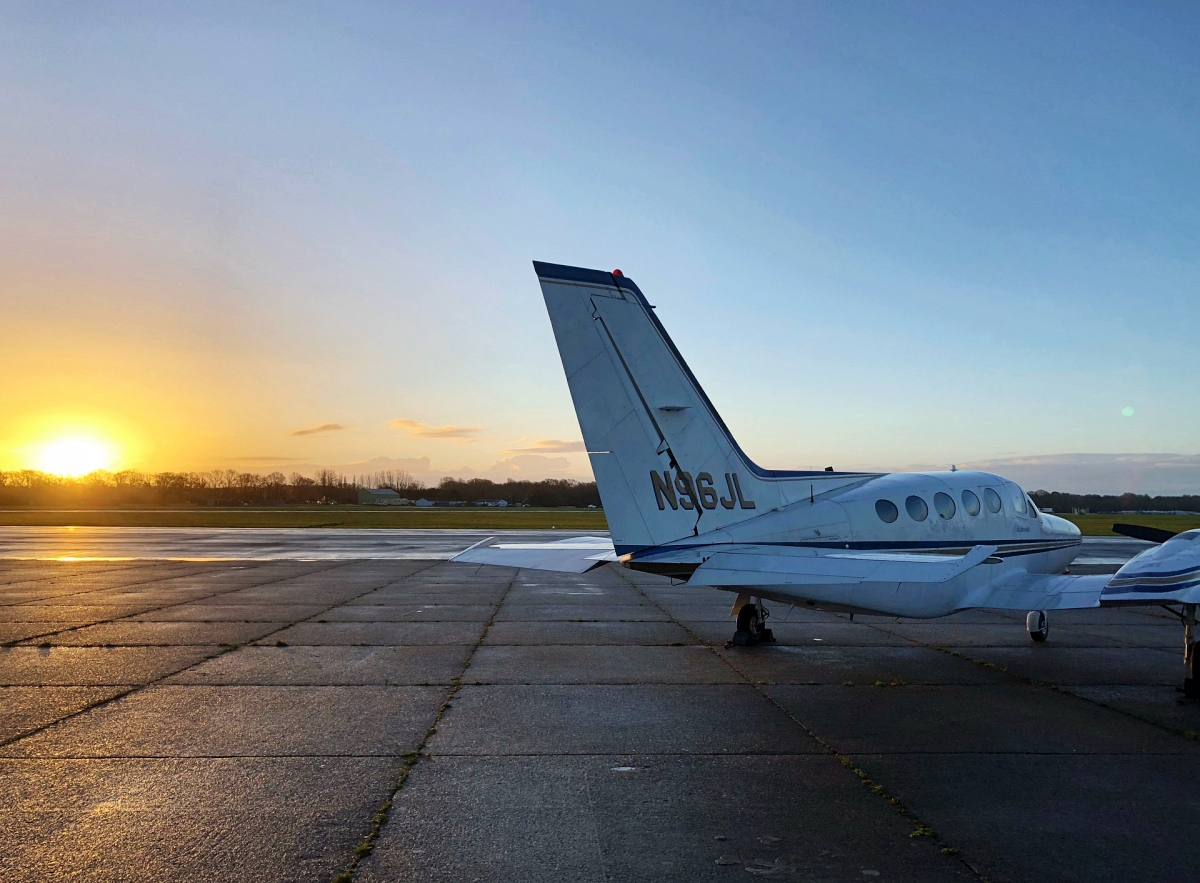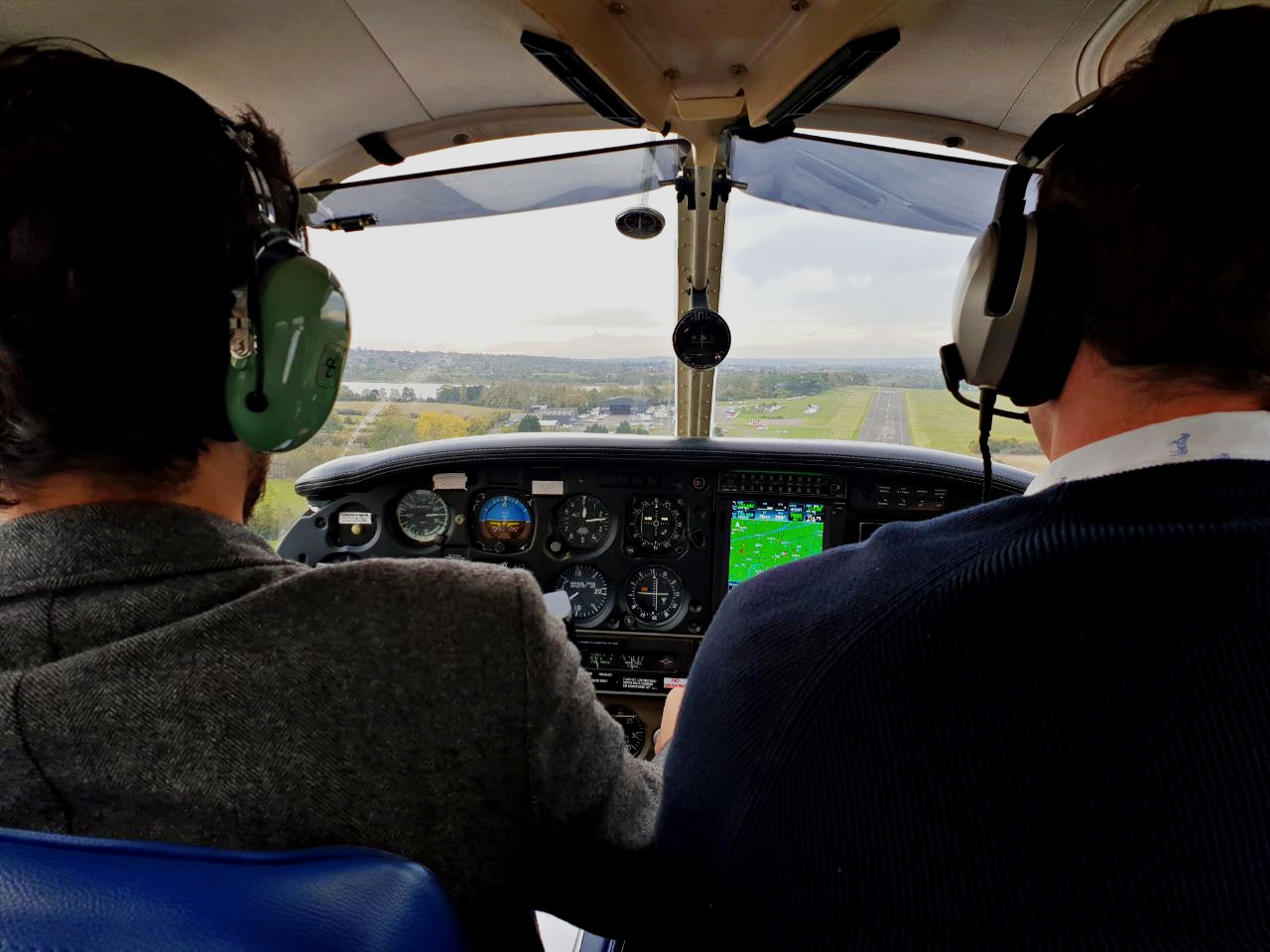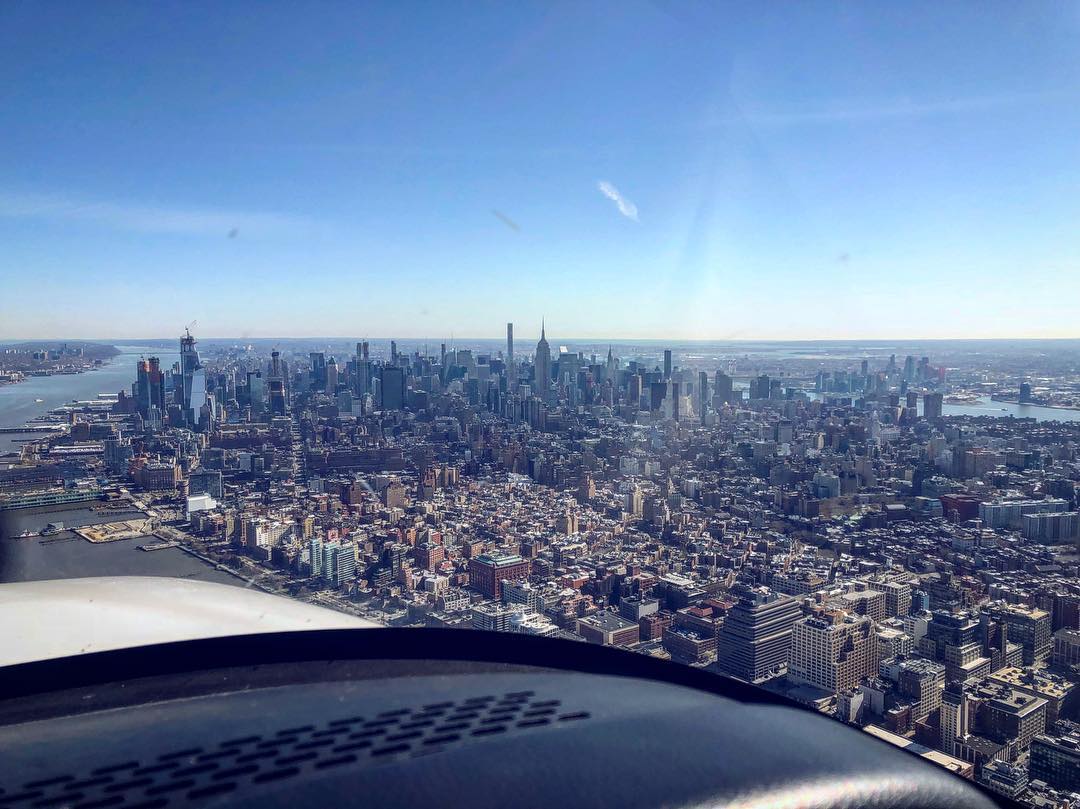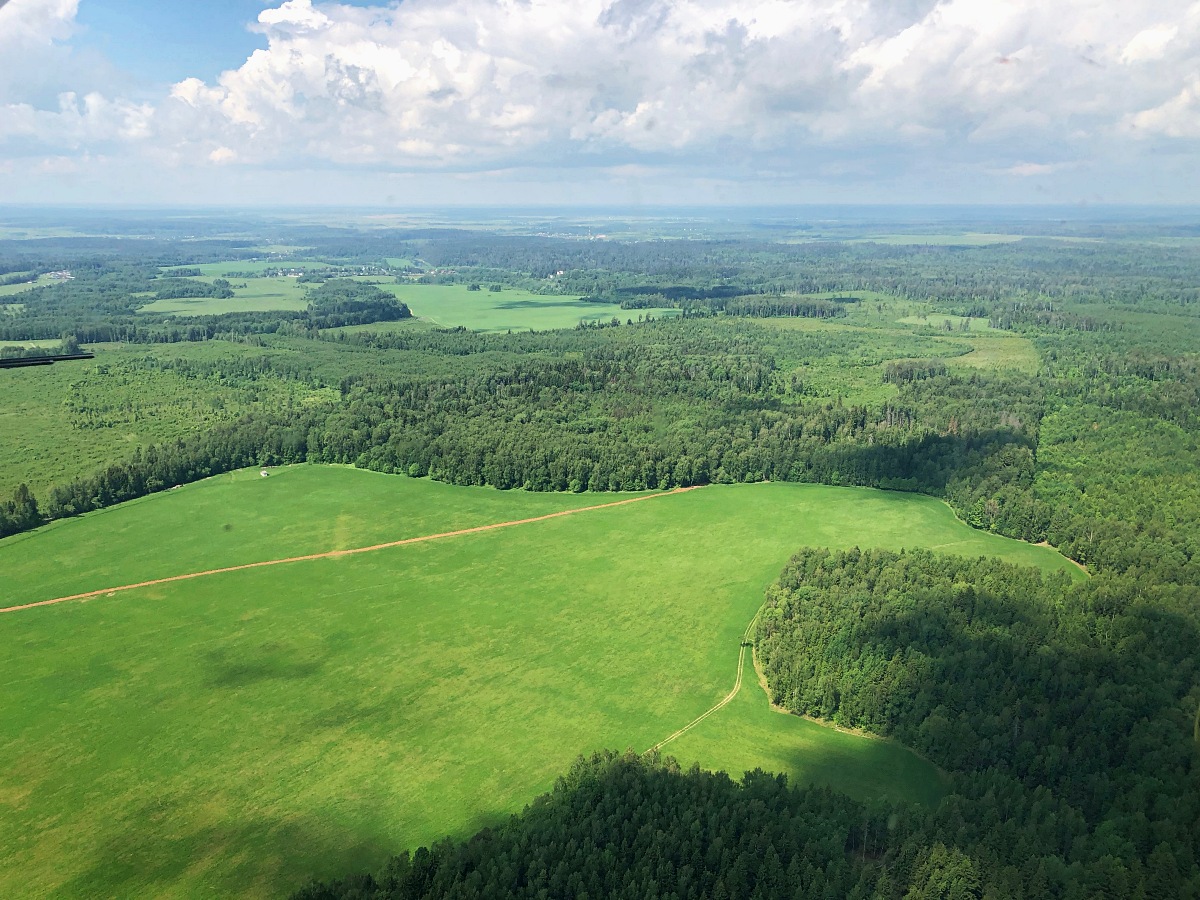How to come to the sky and become a pilot

Hello! Today I will talk about how you can come to heaven, what you need to do to do this, how much it all costs. I will also share my experience of training in a private pilot in the UK and dispel some of the myths associated with aviation. There is a lot of text and photos under the cut :)
First flight
To begin, let's see how to be at the helm. Although I study in London, but I try to fly in every country I visit. In all countries this is done in approximately the same way.

San Francisco from 3000 feet, sunset
First of all, you need to find the nearest airfield to us. For Russia, Ukraine, Belarus and Kazakhstan it makes sense to open maps.aopa.ru and look at the airfields there. In Europe / USA you can simply google airports. We need small (Heathrow will not work!) Airfields as close as possible to the city. If the search does not give anything, you can install a trial version of ForeFlight / Garmin Pilot / SkyDemon and see the airfields on the map. In the end, you can ask the opinion of familiar pilots (if any) or search for aviation chattiki in the Telegram.
- Moscow
- Mozhaisky aerograd
- Vatulino airfield
- St. Petersburg
- Airfield Gostilitsy
- Kiev
- Chaika airfield
- Borodianka airfield
- Airfield Gogolev
- London
- Elstree aerodrome
- Biggin hill airport
- Stapleford aerodrome
- Rochester airport
- Paris
- Saint-Cyr Aerodrome
- Cannes, Nice
- Aéroport Cannes Mandelieu
- Rome
- Rome Urbe Airport
- New York
- Republic airport
- San Francisco, Auckland Valley
- Hayward Executive Airport
After we found the airfield, we need to look at his website for information about flight schools. In principle, you can immediately start flying school and google. If you haven’t managed to find a flight school, look for some “airplane flights to St. Petersburg”. Our task now is to find someone who is ready to show us the world of aviation.
Now it remains only to contact the one we found. We call, ask for the opportunity to ride the plane at the helm (in English this is a trial or gift flight ), book a convenient day for us and that's it. Nothing more to do.
From the real flight on a real plane you are separated by just one call. Contrary to common myths and stereotypes, you do not need to pass for this VLEK (flight medical examination) or take exams in theory. It works even when you are just a tourist. Even if you have no idea how to fly a plane.
It will cost about $ 220 per hour. This figure includes: the cost of fuel, the fee for the maintenance of the aircraft on a schedule, the salary of your instructor, as well as fees for taking off and landing the airfield. The cost may vary slightly depending on the country (in England a bit more expensive, in Russia a bit cheaper). Yes, this is not the cheapest pleasure, but at the same time not cosmically expensive. To rent a private jet does not necessarily have to be a millionaire. And you are usually allowed to take passengers along, and they too can share the cost of the flight with you.
I will emphasize separately: it is very simple to come to the sky, you only need one call from you . And it's worth it. No words, photos or videos will convey the sensations that open during the flight . Each person has his own. This is a feeling of freedom, inspiration and new horizons. At first, it’s a little scary to hold your own life in your own hands, even with an instructor nearby. However, after the first flight comes the realization that we must still try to start taking risks. Fly is no more difficult than driving a car, just a safe flight requires a fairly large amount of knowledge. For security and instructor monitors.
Be prepared for the fact that you will not be allowed to take off and land during your first flight. Typically, airfields for private aviation are not very large and have a number of local features (trees at the end of the strip, short strip, unpaved strip, “humpback” strip). Exceptions for those who like to fly in a simulator and pilots are almost never done. However, the amount of new information and so will roll over, so you will not be bored :)

Curious pond near Rome
Pilot licenses
Ok, suppose the flight has stopped you and you now want to have your license. Is it difficult to do this? The answer depends on what kind of license you want. There are three main types of licenses.
PPL (Private Pilot License, private pilot license)
Opportunities :
- Non-commercial flights on airplanes. In other words - you have no right to earn on it.
- However, in some countries you can share the cost of fuel with passengers (yes, you can take passengers on board)
- You can fly on a huge range of aircraft, ranging from reciprocating to some jet
- You can not fly on airplanes that are certified under a commercial license (for example, Boeing or Airbus)
- You can rent planes in a bunch of flight clubs or buy your own (and it is much cheaper than it seems)
- The license is valid worldwide, the only restriction is that you can only fly on airplanes registered in the country that issued you the license (in America you can fly with a Russian license on a Russian aircraft)
- You can come with a foreign license to Russia and get a Russian license with little or no training (thereby unlocking all Russian aircraft). This process is called validation.
- Can cross international borders
Requirements :
- Medical certificate of airworthiness. Loyal enough, including visually
- Completed a theory course, the easiest. More details below
- The presence of a small amount of raid (42 hours in Russia / 45 in Europe / 40 in the States)
- Passed practice exam

Lakhta Center, St. Petersburg
CPL (Commercial Pilot License, Commercial Pilot License)
Opportunities :
- All the same as for PPL
- Work in the airline or business aviation
- Flying on passenger liners
Requirements :
- Availability of PPL
- About 200 hours of flight time per PPL
- More rigorous medical check
- More rigorous exams
ATPL (Airline Transport Pilot License, linear pilot certificate)
Opportunities :
- All the same as in CPL
- Ability to work as an aircraft commander on airliners
Requirements :
- CPL availability
- Availability of about 1500 hours of flight time by CPL
- Usually nominated for this license by the airline
As you can see, each next license level requires a previous one. This means that, having obtained the license of a private pilot, you will unlock for yourself the opportunity to obtain a commercial license, and in a potential future - go to work for an airline ( in Russia does not work, they want a college diploma ).
In addition to licenses, it is worth mentioning the so-called ratings , which open additional opportunities for each type of license:
- Night Rating - flights at night
- Instrument Rating - flights under instrumental conditions (for example, in fog). Also provides the ability to fly on airways.
- Multi-Engine Rating - flights on airplanes with two or more engines
- Type Rating - flights on a specific aircraft model. These are usually complex planes like Airbus or Boeing.
- And a bunch of others for your taste and fantasy
Hereinafter we will consider the features of PPL training - in the absence of the author of the rest :)

Landing approach in london
Before training
Abroad there are many organizations that standardize licenses, but so far two are worth highlighting:
- FAA (Federal Aviation Administration) - US licenses
- EASA (European Union Aviation Safety Agency) - licenses for the whole of Europe (that is, you can fly on a French plane with an Italian pilot license)
For FAA licenses, they usually fly to Florida. There are good weather conditions and a large selection of schools, but prices are not the cheapest. Alternatively, you can learn in the central part of the United States (for example, in Texas), where prices will be slightly lower.
EASA is obtained in Spain, the Czech Republic or the Baltic countries. They have a good balance between the weather and the cost of training. After completing the training, both licenses can be easily validated in Russia.
Of course, no one bothers you to learn to fly in Russia. However, it is worth noting that in Russia there were situations when flight schools were closed and licenses from their graduates were revoked. A well-chosen flight school largely protects you from such situations, but no one can give guarantees.
In good schools, a lot of attention is paid to flight safety, psychology and the development of proper commanding character. You will be taught to check the checklist meticulously, to analyze the weather very carefully, to avoid absolutely any risks in all situations and to make the right decisions. Incident statistics show that this really works.
Also pay attention to the learning format. Some flight schools offer to immediately pay for all the necessary hours of raids, some to buy packages for 10 hours, some just offer to pay for each hour of flight separately. Choose a training format convenient for you. If, for example, you reside nearby, the most convenient format would be hourly rates. Keep in mind that there is no requirement dictating to be trained in a specified period - you can fly at least an hour a month until you have reached the required number of hours.
The theory is sometimes taught on the spot, sometimes given for correspondence courses from books. In the States can also offer educational videos.
Look closely at the condition of the aircraft, pay attention to how well the instructor “trains” you on the procedures during the trial lesson. A good instructor should teach you to read the checklist thoughtfully and not ask you to skip them, especially when there is enough time.
Finally, it makes sense to undergo a medical examination before the start of training. The European certificate is given very loyally, practically nothing is required of you. The Russian VLEK, which everyone likes to scare so much, is also very much simplified for private pilots. However, there is no risk to go through, and it’s best to know about it before you start spending money on training. In Russia, this is generally a legislative requirement.

Manhattan, New York
Theory
From here on, I will speak directly about the EASA license training. In other countries, the details will be different.
The theory is not as bad as it is painted. You will need to read a few books and prepare for the 9 theoretical exams.
- Air Law - Air Law. Learn about the types of airspace, flight rules, border crossings, requirements for aircraft and pilots.
- Operation Procedures - will tell you about some procedures, like extinguishing a fire in flight, landing on wet lanes, working with wind shears and a turbulent wake from other aircraft.
- Human Performance and Limitations . Optical, auditory and spatial illusions, the effect of sleep on flights, aviation psychology, decision making, first aid.
- Navigation - navigation in the sky. Navigator calculation, accounting for wind, correct recognition of reference points, correction of navigation errors, calculation of fuel, basics of radio navigation.
- Communication . Communication with controllers, flight procedures in the airspace of different classes, giving signals of urgency and distress, the intersection of airspace and militarized zones.
- Meteorology . How clouds and wind form, what clouds cannot be flown into, what dangers await at the boundaries of weather fronts, how to read aviation weather reports (METAR and TAF).
- Principles of Flight . Where does the lift force come from, how does the keel and stabilizer work, how is the plane controlled on three axes, why is stalling happening.
- Aircraft General Knowledge . How does the aircraft itself, its system, how the engine and all devices.
- Flight Performance and Planning . Calculation of the balancing of the aircraft, its load required for the run length
Yes, the list looks impressive, but the questions on the exams are quite simple. Some just trivially memorize the answers. However, I would not advise doing this - each of these items is necessary and can save your life.

Flights to Moscow region, Vatulino neighborhood
Practice
Practice often begins in parallel with theory, and sometimes before.
You will start with basic things - the influence of control surfaces and engine thrust on aircraft behavior. Then you will be taught to steer on the ground and maintain horizontal and straight flight in the air. After that, you have to master the correct techniques of climb and descent. In the next lesson you will be shown how to make turns, including in the set or reduction.
Then start a little extreme. You will start to perform slow flights, with a sounding stall alarm, then stalling itself and, possibly, a corkscrew (yes, almost all training aircraft can do this). Here you can be taught how to make turns with a big roll and take the plane out of the helix - another very insidious thing. As you understand, it is necessary to develop the ability to avoid such situations, and in the cases of the situations themselves it is safe to leave them.
Then, finally, the so-called conveyors will begin at the aerodrome. You will fly a rectangular pattern around the airfield, simultaneously learning to take off and, yes, landing. After you learn how to confidently land an aircraft, including with a side wind, without an engine and flap, you are entrusted with the holy of holies of any cadet - the first independent flight. It will be scary, even if you feel like a bird in the air.
From now on, you will be given more opportunities to fly on your own. The sky does not forgive uncorrected errors, and you have to realize it alone, without the instructor directing you. You will learn the most important skill of the commander - decision-making skills. Of course, you will be followed very carefully from the ground (and in which case you will definitely be helped).
Then the flights will begin on the route. You will start flying to other airfields, getting out of situations when you are lost, planning route changes right in the air, trying to intercept radials from beacons. You have to fly to a certain point and turn back, then fly to another airfield and in the end, perhaps fly to a large, controlled international airport. And all this at first with an instructor, then yourself.
Then you will begin to prepare for the exam. To begin with, you will have to make a large and complex flight en route, with several stops at airports. On their own. Such cross country solo is called. Then you repeat some exercises from the very beginning to make sure that you can pass the exam.
Well, the exam itself. Consists of several sections, takes several hours. His task is to make sure that you can not fly perfectly, but safely.
In Europe, you will still need to pass a practical exam on radio exchange and, possibly, a separate exam on knowledge of the English language. The latter will not be a particular problem after reading books and practical radio exchange, which you will learn in flying :)

Flying at sunset is amazing, but there’s nothing to do without sunglasses
Inspiration
Aviation is not just flying. This is an opportunity to realize much more than what is available to us. This is an opportunity to learn to be responsible, to treat mistakes correctly, listen to other people and inspire them. This is an opportunity to learn the right solutions, the right management of the team, the correct assessment of their own resources, risk management and safety assessment. This is an opportunity to be anywhere and see our familiar cities from a different angle.
This is an opportunity to get acquainted with one of the most interesting communities, where almost always the guys try to help each other. The opportunity to meet many interesting people and make new friends in almost every corner of the world.
I repeat once again that not a single text, video or photo will convey the sensations from the minute of the flight. You need to come and try everything yourself. And it is not so difficult at all. Come to heaven, try yourself in it! Here is a bit of inspiration for you:
- My channel in Telegram , where I regularly talk about my flights
- Denis Okan's Sky Stories
- Pilot's Channel Notes on YouTube
- Kudri.fm channel on YouTube
- Mentour Pilot YouTube Channel (English)
Taking this opportunity, I want to express my deep gratitude to all those people who criticized the article before publication.
You will meet you on takeoff, and maybe we will still hear each other on frequency!

')
Source: https://habr.com/ru/post/455902/
All Articles